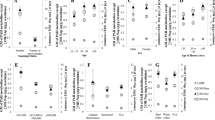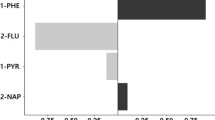Abstract
Urinary mono-hydroxy polycyclic aromatic hydrocarbons (OH-PAHs) are commonly used in biomonitoring to assess exposure to polycyclic aromatic hydrocarbons (PAHs). Similar to other biologically non-persistent chemicals, OH-PAHs have relatively short biological half-lives (4.4–35 h). Little information is available on their variability in urinary concentrations over time in non-occupationally exposed subjects. This study was designed to (i) examine the variability of nine urinary OH-PAH metabolite concentrations over time and (ii) calculate sample size requirements for future epidemiological studies on the basis of spot urine, first-morning void, and 24-h void sampling. Individual urine samples (n=427) were collected during 1 week from 8 non-occupationally exposed adults. We recorded the time and volume of each urine excretion, dietary details, and driving activities of the participants. Within subjects, the coefficients of variation (CVs) for the wet-weight concentration of OH-PAHs in all samples ranged from 45% to 297%; creatinine adjustment reduced the CV to 19–288% (P<0.001; paired t-test). The simulated 24-h void concentrations were the least variable measure, with CVs ranging from 13% to 182% for the 9 OH-PAHs. Within-day variability contributed on average 84%, and between-day variability accounted for 16% of the total variance of 1-hydroxypyrene (1-PYR). Intraclass correlation coefficients of 1-PYR levels were 0.55 for spot urine samples, 0.60 for first-morning voids, and 0.76 for 24-h voids, indicating a high degree of correlation between urine measurements collected from the same subject over time. Sample size calculations were performed to estimate the number of subjects required for detecting differences in the geometric mean at a statistical power of 80% for spot urine, first-morning, and 24-h void sampling. These data will aid in the design of future studies of PAHs and possibly other biologically non-persistent chemicals and in the interpretation of their analytical results.
This is a preview of subscription content, access via your institution
Access options
Subscribe to this journal
Receive 6 print issues and online access
$259.00 per year
only $43.17 per issue
Buy this article
- Purchase on Springer Link
- Instant access to full article PDF
Prices may be subject to local taxes which are calculated during checkout




Similar content being viewed by others
Abbreviations
- CV:
-
coefficient of variation
- GM:
-
geometric mean
- ICC:
-
intraclass correlation coefficient
- OH-PAH:
-
mono-hydroxy polycyclic aromatic hydrocarbon
- 1-PYR:
-
1-hydroxypyrene
- PAH:
-
polycyclic aromatic hydrocarbon
References
ATSDR. Toxicological Profile for Polycyclic Aromatic Hydrocarbons. Agency for Toxic Substances and Disease Registry, Atlanta, 1995 Available: http://www.atsdr.cdc.gov/toxprofiles/tp69.html (accessed 1 October 2008).
Barr D.B., Wilder L.C., Caudill S.P., Gonzales A.J., Needham L.L., and Pirkle J.L. Urinary creatinine concentrations in the U.S. population: implications for urinary biologic monitoring measurements. Environ Health Perspect 2005: 113: 192–200.
Boogaard P.J., and van Sittert N.J. Exposure to polycyclic aromatic hydrocarbons in petrochemical industries by measurement of urinary 1-hydroxypyrene. Occup Environ Med 1994: 51: 250–258.
Bostrom C.E., Gerde P., Hanberg A., Jernstrom B., Johansson C., and Kyrklund T., et al. Cancer risk assessment, indicators, and guidelines for polycyclic aromatic hydrocarbons in the ambient air. Environ Health Perspect 2002: 110 (Suppl 3): 451–488.
Brzeznicki S., Jakubowski M., and Czerski B. Elimination of 1-hydroxypyrene after human volunteer exposure to polycyclic aromatic hydrocarbons. Int Arch Occup Environ Health 1997: 70: 257–260.
Buckley T.J., and Lioy P.J. An examination of the time course from human dietary exposure to polycyclic aromatic hydrocarbons to urinary elimination of 1-hydroxypyrene. Br J Ind Med 1992: 49: 113–124.
Diggle P.J., Liang K., and Zeger S.L. Analysis of Longitudinal Data. Oxford University Press, Oxford, 1994. pp. 27–31
Fromme H., Bolte G., Koch H.M., Angerer J., Boehmer S., and Drexler H., et al. Occurrence and daily variation of phthalate metabolites in the urine of an adult population. Int J Hyg Environ Health 2007: 210: 21–33.
Grimmer G., Dettbarn G., and Jacob J. Biomonitoring of polycyclic aromatic hydrocarbons in highly exposed coke plant workers by measurement of urinary phenanthrene and pyrene metabolites (phenols and dihydrodiols). Int Arch Occup Environ Health 1993: 65: 189–199.
Han I.K., Duan X., Zhang L., Yang H., Rhoads G.G., and Wei F., et al. 1-Hydroxypyrene concentrations in first morning voids and 24-h composite urine: intra- and inter-individual comparisons. J Expo Sci Environ Epidemiol 2008: 18: 477–485.
Hansen A.M., Raaschou-Nielsen O., and Knudsen L.E. Urinary 1-hydroxypyrene in children living in city and rural residences in Denmark. Sci Total Environ 2005: 347: 98–105.
Hauser R., Meeker J.D., Park S., Silva M.J., and Calafat A.M. Temporal variability of urinary phthalate metabolite levels in men of reproductive age. Environ Health Perspect 2004: 112: 1734–1740.
IARC. IARC Monographs on the Evaluation of Carcinogenic Risk of Chemicals to Man: Polycyclic Aromatic Compounds, Part 1, Chemical and Environmental data, vol 32, International Agency for Research on Cancer. IARC, Lyon, 1983 Available: http://monographs.iarc.fr/ENG/Monographs/vol32/volume32.pdf (last accessed 8 February 2009).
IPCS World Health Organization. Environmental Health Criteria 155—Biomarkers and Risk Assessment: Concepts and Principles, 1993 Available: http://www.inchem.org/documents/ehc/ehc/ehc155.htm (accessed 1 October 2008).
Jacob J., and Seidel A. Biomonitoring of polycyclic aromatic hydrocarbons in human urine. J Chromatogr B Analyt Technol Biomed Life Sci 2002: 778: 31–47.
Jongeneelen F.J., Van Leeuwen F.E., Oosterink S., Anzion R.B., van der L.F., and Bos R.P., et al. Ambient and biological monitoring of cokeoven workers: determinants of the internal dose of polycyclic aromatic hydrocarbons. Br J Ind Med 1990: 47: 454–461.
Kissel J.C., Curl C.L., Kedan G., Lu C., Griffith W., Barr D.B., Needham L.L., and Fenske R.A. Comparison of organorphosphorus pesticide metabolite levels in single and multiple daily urine samples collected from preschool children in Washington State. J Expos Anal Environ Epidemiol 2005: 15: 164–171.
Levin J.O., Rhen M., and Sikstrom E. Occupational PAH exposure: urinary 1-hydroxypyrene levels of coke oven workers, aluminium smelter pot-room workers, road pavers, and occupationally non-exposed persons in Sweden. Sci Total Environ 1995: 163: 169–177.
Li Z., Romanoff L.C., Trinidad D.A., Hussain N., Jones R.S., and Porter E.N., et al. Measurement of urinary monohydroxy polycyclic aromatic hydrocarbons using automated liquid-liquid extraction and gas chromatography/isotope dilution high-resolution mass spectrometry. Anal Chem 2006: 78: 5744–5751.
Li Z., Sandau C.D., Romanoff L.C., Caudill S.P., Sjodin A., and Needham L.L., et al. Concentration and profile of 22 urinary polycyclic aromatic hydrocarbon metabolites in the US population. Environ Res 2008: 107: 320–331.
Maroni M., Colosio C., Ferioli A., and Fait A. Biological monitoring of pesticide exposure: a review. Toxicology 2000: 143: 5–118.
McGraw K.O., and Wong S.P. Forming inferences about some intraclass correlation coefficients. Psychol Methods 1996: 1: 30–46.
Mucha A.P., Hryhorczuk D., Serdyuk A., Nakonechny J., Zvinchuk A., and Erdal S., et al. Urinary 1-hydroxypyrene as a biomarker of PAH exposure in 3-year-old Ukrainian children. Environ Health Perspect 2006: 114: 603–609.
Needham L.L., and Sexton K. Assessing children's exposure to hazardous environmental chemicals: an overview of selected research challenges and complexities. J Expos Anal Environ Epidemiol 2000: 10: 611–629.
Ovrebo S., Haugen A., Hemminki K., Szyfter K., Drablos P.A., and Skogland M. Studies of biomarkers in aluminum workers occupationally exposed to polycyclic aromatic hydrocarbons. Cancer Detect Prev 1995: 19: 258–267.
Scher D.P., Alexander B.H., Adgate J.L., Eberly L.E., Mandel J.S., and Acquavella J.F., et al. Agreement of pesticide biomarkers between morning void and 24-h urine samples from farmers and their children. J Expo Sci Environ Epidemiol 2007: 17: 350–357.
Siwinska E., Mielzynska D., Smolik E., Bubak A., and Kwapulinski J. Evaluation of intra- and interindividual variation of urinary 1-hydroxypyrene, a biomarker of exposure to polycyclic aromatic hydrocarbons. Sci Total Environ 1998: 217: 175–183.
U.S.EPA. Occupational and Residential Exposure Test Guidelines: 875.1500 Biological Monitoring, 1996 Available: http://www.epa.gov/opptsfrs/publications/OPPTS_Harmonized/875_Occupational_and_Residential_Exposure_Test_Guidelines/Series/875-1500.pdf (accessed 1 October 2008).
Van Rooij J.G.M., Veeger M.M.S., Bodelier-Bade M.M., Scheepers P.T.J., and Jongeneelen F.J. Smoking and dietary-intake of polycyclic aromatic-hydrocarbons as sources of interindividual variability in the base-line excretion of 1-hydroxypyrene in urine. Int Arch Occup Environ Health 1994: 66: 55–65.
Viau C., Carrier G., Vyskocil A., and Dodd C. Urinary excretion kinetics of 1-hydroxypyrene in volunteers exposed to pyrene by the oral and dermal route. Sci Total Environ 1995: 163: 179–186.
Viau C., Lafontaine M., and Payan J.P. Creatinine normalization in biological monitoring revisited: the case of 1-hydroxypyrene. Int Arch Occup Environ Health 2004: 77: 177–185.
Viau C., and Vyskocil A. Patterns of 1-hydroxypyrene excretion in volunteers exposed to pyrene by the dermal route. Sci Total Environ 1995: 163: 187–190.
Acknowledgements
We thank the study participants for their time and devotion. We also thank Pam Olive and Dr Mary Kimberly for supplying the creatinine measurements.
Author information
Authors and Affiliations
Corresponding author
Ethics declarations
Competing interests
The authors declare no conflict of interest.
Additional information
Supplementary Information accompanies the paper on the Journal of Exposure Science and Environmental Epidemiology website
Supplementary information
Rights and permissions
About this article
Cite this article
Li, Z., Romanoff, L., Lewin, M. et al. Variability of urinary concentrations of polycyclic aromatic hydrocarbon metabolite in general population and comparison of spot, first-morning, and 24-h void sampling. J Expo Sci Environ Epidemiol 20, 526–535 (2010). https://doi.org/10.1038/jes.2009.41
Received:
Accepted:
Published:
Issue Date:
DOI: https://doi.org/10.1038/jes.2009.41
Keywords
This article is cited by
-
The Transmission of Anxiety from Mothers to Adolescents in Rural China: The Protective Roles of Father-Child Attachment Security and Friend Support
Journal of Child and Family Studies (2024)
-
Environmental polycyclic aromatic hydrocarbon exposure is associated with low back pain
Environmental Geochemistry and Health (2023)
-
Disturbance of OH-PAH metabolites in urine induced by single PAH lab exposure
Environmental Science and Pollution Research (2023)
-
Sex-specific effect of urinary metabolites of polycyclic aromatic hydrocarbons on thyroid profiles: results from NHANES 2011–2012
Environmental Science and Pollution Research (2023)
-
The relationship between polycyclic aromatic hydrocarbons exposure and serum klotho among adult population
BMC Geriatrics (2022)



